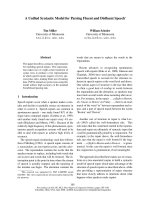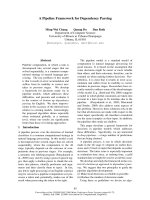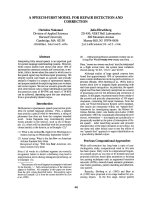Báo cáo khoa học: "A PARSING METHOD OR INFLECTIONAL FREE WORD ORDER LAN" docx
Bạn đang xem bản rút gọn của tài liệu. Xem và tải ngay bản đầy đủ của tài liệu tại đây (329 KB, 4 trang )
~%D-WAY FINITE ~% AND D~a-I~NDENCY GRAMMAR:
A
PARSING METHOD ~-OR INFLECTIONAL FREE WORD ORDER LAN(~I%GES I
Esa Nelimarkka, Harri J~ppinen and Aarno Lehtola
Helsinki University of Technology
Helsinki, Finland
ARSTRACT
This paper presents a parser of an
inflectional free word order language, namely
Finnish. Two-way finite automata are used to
specify a functional dependency grammar and to
actually parse Finnish sentences. Each automaton
gives a functional description of a dependency
structure within a constituent. Dynamic local
control of the parser is realized by augmenting the
automata with simple operations to make the
automata, associated with the words of an input
sentence, activate one another.
I ~ON
This Daper introduces a computational model
for the description and analysis of an inflectional
free word order language, namely Finnish. We argue
that such a language can be conveniently described
in the framework of a functional dependency grammar
which uses formally defined syntactic functions to
specify dependency structures and deep case
relations to introduce semantics into s%mtax. We
show how such a functional grammar can be compactly
and efficiently modelled with finite two-way
automata which recognize the dependants of a word
in various syntactic functions on its both sides
and build corresponding dependency structures.
The automata along with formal descriptions of
the functions define the grammar. The functional
structure specifications are augmented with simple
control instructions so that the automata
associated with the words of an input sentence
actually parse the sentence. This gives a strategy
of local decisions resulting in a strongly data
driven left-to-right and bottom-up parse.
A parser based on this model is being
implemented as a component of a Finnish natural
language data base interface where it follows a
separate morphological analyzer. Hence, throughout
the paper we assume that all relevant morphological
and lexical information has already been extracted
and is computationally available for the parser.
I This research is s,~pported by SITRA (Finnish
National Fund for Research and Development).
Although we focus on Finnish we feel that the
model and its specification formalism might be
applicable to other inflectional free word order
languages as well.
II LINGUISTIC MOIT~ATI ON
There are certain features of Finnish which
suggest us to prefer dependency grammar to pure
phrase structure grammars as a linguistic
foundation of our model.
Firstly, Finnish is a "free word order"
language in the sense that the order of the main
constituents of a sentence is relatively free.
Variations in word order configurations convey
thematical and discursional information. Hence, the
parser must be ready to meet sentences with variant
word orders. A computational model should
acknowledge this characteristic and cope
efficiently with it. This demands a structure
within which word order variations can be
conveniently described. An important case in point
is to avoid structural discontinuities and holes
caused by transformations.
We argue that a functional depend s~cy-
constituency structure induced by a dependency
grammar meets the requirements. This structure
consists of part-of-whole relations of constituents
and labelled binary dependency relations between
the regent and its dependants within a constituent.
The labels are pairs which express syntactic
functions and their semantic interpretations.
For example, the sentence "Nuorena poika
heitti kiekkoa" ("As young, the boy used to throw
the discus") has the structure
heitti
adver bial~ubj~ t~.~ object
Nuorena poika kiekkoa
or, equivalently, the linearized structure
( (Nuorena)advl (poika) ~ubj he~tti (kiekkoalob j I,
TIW~ AGF/~ N~
L~;J,
389
ar~@, w!th
[". -~
ich
:,'),~u~ i
[:dent, the
,,x.:,,rd
without
[nflected %ocd d~)peaLs as a complex of its syntac-
tic, .morphological and semantic properties. Hence,
our sentence structure is a labelled tree whose
nodes are complex expressions.
The advantage of the functional dependency
structures lies in the fact that many word order
varying transformations can be described as
permutations of the head and its labellex9
dependants in a constituent. Reducing the depth of
structures (e.g. by having a verb and its subject,
object, adverbials on the same level) we bypass
many discontinuities that would otherwise appear in
a deeper structure as a result of certain
transformations. As an example we have the
permutations
((Poika) subj heitti (kiekkoa)obj (nuorena)advl)
(Heittik~ (poika) subj (nuorena) advl (kiekkoa) obj)
and
((Kiekkoako)obj
(poika) subj heitti (nuorena) advl).
("The bov used to threw the discus when he was
young", "Did the boy use to throw ?", "Was it
discus that the boy used to throw ?",
respectively. )
The second argunent for our choices is the
well acknowledged prominent role of a finite verb
in regard to the form and meaning of a sentence.
The meaning of a verb includes, for example,
knowledge of its deep cases, and the choice of a
particular verb to express this meaning determines
to a great extent what deep cases are present on
the surface level and in what functions. Moreover,
due to the relatively free word order of Finnish,
the main means of indicating the function of a word
in a sentence is the use of surface case suffixes,
and very often the actual surface case depends not
only on the intended function or role but on the
verb as Well.
Finally, we wish to describe the sentence
analysis as a series of local decisions of the
following kind. Suppose we have a sequence
CI, , Ci_l, Ci, Ci+l, , C n of constituents as
a result of earlier steps of the analysis of an
input sentence, and asinine further that the focus
of the analyzer is at the constituent C i. In such a
situation the parser has to decide whether C i is
(a) a dependant of the left neighbour Ci_l,
(b) the reagent of the left neiqhbour Ci_l,
(CI a d~).~%gant of some
f,~rtU~r,~[n ~ Fie]h+
(a)
": .~ent ~f some. fortJ]coming right
neighbour.
~b.~erv@ that d~c.lsinng f~% and (d) refer
either c~
a
const[tJe~t w~ich alceadv exists on the
right side of C i or which will appear there after
some steps of the analysis. Further, it should be
noticed that We do not want the parser to make any
hypothesis of the syntactic or semantic nature of
the possible dependency relation in (a) and (c) at
this moment.
We claim that a functional combination of
dependency grammar and case grammar can be put into
a computational form, and that the resulting model
efficiently takes advantage of the central role of
a constituent head in the actual parsing pr.ocess by
letting the head find its dependants using
functional descriptions. We outline in the next
sections how we have done this with formally
defined functions and 2-way automata.
III FORMALLY DEFINED ~CTIC FIYNCIXONS
We abstract the restrictions imposed on the
head and its dependant in a given subordinate
relation. Recall that a constituent consists of the
heed - a word regarded as a complex of its relevant
properties - and of the dependants - from zero to n
(sub) constituents.
The traditional parsing categories such as the
(deep structure) subject, object, adverbial and
adjectival attribute will be modelled as functions
f: ~f ->C,
where C is the set of constituents and ~)L e C" C
is the domain of the function.
T
The domain of a function f will be defined
with a kind of Boolean expression over predicates
which test properties of the arguments, i.e. the
regent and the potential dependant. In the analysis
this relation is used to recognize and interprete
an occurance of a <head,dependant>-pair in the
given relation. The actual mapping of such pairs
into C builds the structure corresponding to this
function.
For notational and i~plementational reasons we
specify the functions with a conditional expression
formalism. A (primitive) conditional expression is
either a truth valued predicate which tests
properties of a potential constituent head (R) and
its 4ependant (D) and deletes non-matchina
[mterore~ations of an ambigu(~]s word, or an actier.
which performs one of the basic construction
operations such as labelling (:=), attaching (:-),
or deletion, and returns a truth value.
Primitive expressions can be written into
series (PI P2 Pn) or in parallel (Pl;P2; ;
Pn) to yield complex expressions. Logically, the
former corresponds roughly to an and-operation and
the latter an or-operation. A conditional operation
-> and recursion yield new complex expressions
from old ones.
390
As an exa~91e, consider the expressions
'Object', 'Recobj'
and 'IntObj' in Figure i.
ILMIIII |jilt
IlilKOtjlllntOiJ) -) II I. ObIKtIIC :, IIII(L I)l
18JTlOIts ItKrA J
lilt
• *lrM|JtJv,
"tk~inlll(I •
*lMilliil
*~ntlmcJ)
-) II| • Plrt,, -) 11 •
h)i
ill
•
I~'
")
IJ
•
"f~mtdlil)l
't} " t(mtlkleJli
" ( hi
~j ))l,,,,,,
|(| • ~'I;'IPI'N k(,,ll • POll -) T'I
lit
•
( Ikm )),,l , PH)
-) ,,ll •
IO*)
-) '0 "
PL',,
1() • ~:)(I • ( his
II~t IW~ ( IP 2P )1 ) '''l
,,,,1
• lira
UI'R
• ACt (
lind
Clmd
Pot
(l~I~
~P' )))')
,,Ill
•
*Irlmsit,,ve '41ol|sl])(
I •
-P~l~tence +llolisll))
") 'D " (
IMI ~I
kC Part )
lll.ltllalll
tJt|j
,,,,ll
• (
JoviqVerkl l~qplVlqlll
)) ")
'|
I, Ilvtrl|)):
¢III
•
¢lim'cl~'t'l)(|
* .ililre4tiNl *) li I. lntril,,,,
Figure I.
The relation 'RecObj ' approximates the
syntactic and mDrphological restrictions imposed on
a verb and its nominal object in Finnish. (It
represents partly the partitive-accusative
opposition of an object, and, for an accusative
object, its nominative-genetive distribution.) The
relation 'IntObj', on the other hand, tries to
interprete the postulated object using semantic
features and a subcategorization of verbs with
respect to deep case structures and their
realizations. The semantic restrictions imposed on
t~e underlying deep cases are checked at this
point. 'Object', after a succesful match of these
syntactic and semantic conditions, labels the
postulated dependant (D) as 'Object' and attaches
it to the postulated regent (R).
IV FU~'~ONAL DESCRIPTIONS WI~ ,TflD-~AY AUT(3MA,~
We introduced the formal functions to define
conditions and structures associated with syntactic
dependency relations. What is also needed is a
description of what dependants a word can have and
in what order.
In a free Word order language we would f~ce,
for exile, a paradigm fragment of the form
(subj) V (obj) (advl)
(advl) (subj) V (obj)
V (subj) (obj) (advl)
(obj) (subj) V (advl)
for functional dependency structures of a verb.
(Observe that we do not assume transformations to
describe the variants. ) We combine the descriptions
of such a paradigm int~ a m~dified two-way finite
automaton.
A 2-way finite automaton consists of a set nf
states, one of which is the initial state and some
of which are final states, and of a set of
transition arcs between the states. Each arc
recognizes a word, changes the state of the
automaton and moves the reading head either to the
left or right.
We modify this standard notion to recognize
left and right dependants of a word starting from
its immediate neighbour. Instead of recognizing
words (or word categories) these automata recognize
functions, i.e. instances of abstract relations
between a postulated head and its either
neighbour. In addition to a mare recognition the
transitions build the structures determined by the
observed function, e.g. attach the neighbour as a
dependant, label it in agreement with the function
and its interpretation.
STATE ~ LE.CT
((D • +PhriSe) -) (Subject -) (C I, WS });
(Objlct -) (C I, WO ));
CAdv~bJal -) (C S, .W |);
(SenSubj -) (C :, VS? ));
+(Snti4vl -)
(C
:, .W ));
• IT ,) IC t'~ )));
lID
• -Phrast) -) (C ;- V? ))
|TAT[." V? RISHT
|(D • *Phrase) -) {Subject -) (C s- VS? ));
(Object -) (C ,,. V~ ));
(SlmtPmbj -) |C ,,,- ~r-~ ntS?));
(SntOA| -) (C s. VgmtO? ));
|Mverbial -) (C :, I1? ))t
|SentMvl -)
(C
t" VSmttt? ));
¢T -) ¢C *, "%'Final )|);
led • -Phrise) -) (C ,,, V? )(JuildPhra|eOn RIGHT))
STATE: WS LEFT
(1| • "+Phra$1) -) (Objlct -) (C I, ?VSO ));
(AdvlrbJ,| -) (C I. WS ));
(SlmtMvl -) (C :, VS? });
(T -) (C t" VS? )111
((S • -IP*rlml) -) (C ,," W? 1)
Figure 9.
Figure 2. exhibits part of a verb automaton
which recognizes and builds, for exm~ple, partial
structures like
v v V V V
//////\
subj , obj , advl , obj subj , advl subj
The states are divided into 'left' and 'right'
states ho indicate the side where the dependant is
to be found. Each state indicates the formal
functions which are available for a verb in that
particular state. A succesfull applicati~ of a
f~Jnct[or, transfers the v6.~b [nt~ .~nother :~t~te tc,
[~ok for f,rther d_~?endants.
391
Heuristic rules and look-ahead can a]~>
used, For example, the rule
((RI = ', )(R2 = 'ett~ )(C = +gattr)
-> (C := N?Sattr) (Buil~PhraseOn RI(RT))
in the state N? of the noun automaton anticipates
an evident forthcoming sentence attribute of, say,
a cognitive noun and sets the noun to the state
N?Sattr to wait for this sentence.
V PARSING WITH A SE~CE OF 2-WAY AUTCMATA
So far we have shc~n how to associate a 2-way
automaton to a word via its syntactic category.
This gives a local descriotion of the grammar. With
a few simple control instructions these local
automata are made to activate each other and,
after a sequence of local decisions, actually parse
an input sentence.
An unfinished parse of a
sentence
consists of
a sequence
CI,C2, ,C n
of constituents, which
may be complete or incomplete. Each constituent is
associated with an automaton which is in some state
and reading position. At any time, exactly one of
the automata is active and tries to recognize a
neighbouring constituent as a dependant.
Most often, only a complete constituent (one
featured as '+phrase') qualifies as a potential
dependant. To start the completion of an incomplete
constituent the control has to be moved to its
associated automaton. This is done with a kind of
push operation (BuildPhraseOn RIGHT) which
deactivates the current automaton and activates the
neighbour next to the right (see Figure 2). This
decision corresponds to a choice of type (d). A
complete constituent in a final state will be
labelled as a '+phrase' (along with other relevant
labels such as '+-sentence', '+_nominal', '~main').
Operations (FindRegOn L~T) and (FindRegOn RIGHT),
which correspond to choices (a) and (c), deactivate
the current constituent (i.e. the corresponding
automaton) and activate the leftmost or rightmost
constituent, respectively. Observe that the
automata need not remember when and why they were
activated. Such simple "local control" we have
outlined above yields a strongly data driven
bottom-up and left-to-right parsing strategy which
has also top-down features as expectations of
lacking, aependants.
ATN-par sets. (There are also other major
differences. ) In our dependency oriented model
non-terminal categories (S, VP, NP, AP, ) are
not needed, and a constituent is not postulated
until its head is found. This feature separates our
parser from those which build pure constituent
structures without any reference to dependency
relations within a constituent. In fact, each word
collects actively its dependants to make up a
constituent where the word is the head.
A further characteristic of our model is the
late postulation of syntactic functions and
semantic roles. Constituents are built blindly
without any predecided purpose so that the
completed censtituents do not know why they were
built. The function or semantic role of a
constituent is not postulated tmtil a neighbour is
activated to recognize its own dependants. Thus, a
constituent just waits to be chosen into some
function so that no registers for functions or
roles are needed.
VII REF~S
Hudson, R. : Arguments for a Non-transformational
Grammar. The University "6f" ~ ~ ~-6.
Hudson, R.: Constituency and Dependency.
Linguistics 18, 1980, 179_.198.
J~pinen, H., Nelimarkka, E., Lehtola, A. and
Ylilammi, M.: Knowledge engineering approach to
morphological analysis. Proc. of the First
Conference of the European Chapter of ACL, Pisa,
1983, 49-51.
Lehtola, A.: Compilation and i,~lementation of
2-way tree automata for the parsing of Finnish.
HeLsinki University of ~chnology (forthcoming
M.Sc. the thesis).
Nelimarkka, E., J~ppinen, H. and Leh~ola A.:
Dependency oriented parsing of an inflectional
language (manuscript).
VI DISCUSSION
AS we have shown, cur parser consists of a
collection of finite transition networks which
.~c~:,~u'~ ~:h
~J~er. The ~.=e of ~-wa V instead of
i-why ~ut: ~mat ~ :] i[~t h~.gui 5he~ o.ic parse[
f['om
392









